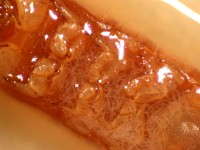Benefit From Beneficial Nematodes

With a variety of factors driving pest management changes in horticultural operations, many professionals are looking to expand their use of biological control agents (BCAs), including the use of beneficial nematodes. Growers find beneficial nematodes to be an attractive addition to existing pest management programs because they reduce or eliminate restricted-entry intervals, have limited impact to worker and customer safety, promote environmental stewardship and are valuable pesticide resistance and residue management tools.
While great strides have been made in the development of effective beneficial nematodes over the past several years, there is still confusion among growers about these little worms. How do they work? Do they cause damage? How should I use beneficial nematodes in the greenhouse? Read on to learn the answers to these questions and more.
How Beneficial Nematodes Work
Beneficial nematodes, also known as entomopathogenic nematodes or insect-parasitic nematodes, are microscopic, un-segmented roundworms. They are naturally-occurring and are already present in the soil environment. In their infective juvenile stage, beneficial nematodes search out and kill targeted insect pests. Different nematode species attack different pests.
When a beneficial nematode finds its host pest, it enters through natural openings (i.e., mouth, anus and spiracles) or directly through the cuticle. Once inside, the nematodes release a bacterium that kills the host within 24 to 48 hours. The infective juveniles develop into adults and reproduce within the dead insect. Reproduction inside the insect results in new generations of nematodes that seek out other pests.
Applications of beneficial nematodes provide continuous control over an extended period. The amount of control will depend on a variety of factors, including application and environment, but typically a beneficial nematode population should last at least two to four weeks.
Use Beneficial Nematodes For Safe Effectiveness
Whatever the reason for starting a beneficial nematode program, growers continue using them because they see consistent control through extended use. There are many other reasons why growers choose to use beneficial nematodes in their operations as well, such as:
Compatibility. Use beneficial nematodes as a stand-alone program or in conjunction with chemical control products or other BCAs, such as insects. The combination of multiple control agents broadens the pest control spectrum and helps to effectively manage all life stages in a pest population.
Many growers are also surprised to learn that beneficial nematodes can be used in a rotational program with conventional insecticides. This approach reduces the number of chemical applications needed for effective pest control, reducing the likelihood that pests will develop pesticide resistance.
Instant Re-Entry Interval. Beneficial nematode products have no re-entry interval (REI), so it is safe to enter the area immediately following applications. If other pesticides or chemicals are included with the application, check their labels for REI information.
No Resistance Concerns. Many species of insects can develop resistance to certain chemicals that have been applied frequently. That is not a concern with beneficial nematodes. They physically enter the body of the pest and release a bacterium that causes the death of the insect. There is no risk of insect pests developing a resistance to beneficial nematodes.
Safety. Beneficial nematodes are host-specific and only affect targeted insect pests. They are harmless to any organism other than the susceptible insects. Because beneficial nematodes are non-toxic and harmless to humans, there are no disposal restrictions and no need for applicators to wear protective gear.
Beginning A Biological Control Program
More growers are experiencing successful pest control with beneficial nematodes as they gain more knowledge and awareness of them. Usually, the growers who experience the most success are the ones who understand how to properly apply beneficial nematodes.
There are a variety of factors that influence nematode efficacy — temperature, humidity, soil moisture, chemical compatibility, spray adjuvants, equipment, mixing — all play a role.
Before making an application, make sure you read the label and any supporting literature. Talk to other growers, distributors, manufacturers or consultants to better understand nematode applications and limitations.
As mentioned, nematodes can be combined with compatible chemicals to help manage insect resistance or to compliment an existing integrated pest management program. Also consider incorporating other biological organisms to more effectively manage all pest life stages. Regardless of the program used, make sure to monitor insect populations, as well as keep detailed pest control records.
Temperature And Moisture Tips For Success
Two major factors affecting nematode efficacy are temperature and moisture. Apply beneficial nematodes to moisten soil when temperatures are below 86ºF. Irrigate before and after nematode applications. Apply nematodes in the early morning or evening to avoid desiccation and UV radiation damage. Pull blackout curtains, increase humidity, turn off lights, close vents, tank-mix with spray adjuvants and increase the application volume to preserve moisture and prolong the life of nematodes in the soil and on foliage.
Keeping your nematodes cool is important at all times, especially during the application process. A simple way to keep nematode solutions cool is by placing a cold pack in the solution.
Application equipment commonly used for conventional insecticides may be used to apply nematodes, but a few modifications will be important for easy passage of the nematodes. Remove filters of 50 mesh or finer from the application equipment. Set pump pressure below 300 psi and do not apply nematodes through mist nozzles with apertures of 0.5 mm.
Mix Nematodes For Even Distribution
It is also critical to prevent nematode solutions from settling during applications. Nematodes quickly settle to the bottom of a solution, resulting in uneven nematode distribution and, subsequently, uneven pest control. Growers use three types of circulation – hand mixing (time consuming and labor intensive), air circulation and mechanical circulation.
Air circulation is the best method for keeping nematode solutions viable due to the ability of air to circulate and oxygenate at the same time. Air circulation systems can utilize a compressed air system (if available), or be composed of an electrical air pump attached to a bubbler. Bubblers can be purchased commercially or be handmade.
Mechanical circulation, such as a recirculation pump or paddle mixer, can be equally effective at keeping nematodes in suspension. However, this method can also heat up water solutions and physically damage nematodes over time. Use nematode solutions within two hours if using mechanical circulation and within four hours for air circulation.
Rid The Greenhouse Of Thrips, Gnats And Flies
With regular nematode applications and effective pest monitoring, you can keep infestations at a low manageable level. Monitor for pests regularly to ensure infestation levels do not exceed action thresholds. If infestation levels get too high, you may need to supplement beneficial nematodes with additional biological control agents and/or pesticide applications.
Beneficial nematodes attack and provide control of a variety of insect pests. Some of the most problematic pests include, but are not limited to:
• Fungus gnats
• Western flower thrips
• Leatherjackets
• White grubs
• Weevils
• Cranberry girdlers
• Mole crickets
• Shore flies
• Borers
• Caterpillars
Beneficial nematodes are commonly used to control western flower thrips, fungus gnats and shore fly larvae. Spray all areas that may contain pest populations. Treat plugs and cuttings before integrating them into the greenhouse to prevent the spread of outside or invasive insect pests.
Developing A Full Integrated Pest Management Program
If beneficial nematodes sound like something you’d like to try, consider developing an extensive integrated pest management (IPM) program using
these tips.
The first stage in developing an IPM plan is to establish action, or economic, thresholds. The economic threshold is the pest population that will trigger pest control decisions. Economic thresholds will vary by plant species and growth stage, plant susceptibility and growing conditions, as well as grower
management preference.
Once economic thresholds have been established, regular pest monitoring should be performed to accurately identify and quantify pest populations over time. Conventional pesticide use is not typically warranted unless pest population exceeds economic thresholds.
Prevention is the first line of pest control. When feasible, plant cultivars should be selected with resistance to common pests. Cultural practices should be adopted that maximize plant growth and vigor because weak plants typically are more susceptible to pests. Pest-proof netting or other physical barriers are often used to prevent insects from moving into or among greenhouses. Preventative and cultural methods that minimize pest populations dramatically increase efficiency of BCAs.
Biological control agents work best under low pest populations and few BCAs provide the rapid and total control afforded by conventional pesticides. Treating pests preventatively with BCAs will maintain a low pest population, making it less likely that pest populations reach economic thresholds. Biological control agents typically should be introduced or applied early in a growing cycle to allow for most effective control.
If pests do reach thresholds, conventional pesticides that are compatible with biological control agents can quickly reduce pest populations to manageable levels. Biorational pesticides like horticultural oils or insect growth regulators often are compatible with many BCAs. Consult BCA suppliers for information regarding pesticide compatibility before making applications. Apply conventional synthetic insecticides responsibly — only treat when necessary and rotate modes of action to limit the potential for targeted pests to develop resistance.
If a conventional pesticide must be used that is not compatible with introduced BCAs, it will be necessary to reintroduce BCAs. Depending on the pesticide, it may take several weeks for residues on treated surfaces to fall to levels low enough not to harm BCAs. Again, consult the BCA supplier for information regarding compatibility and for information on how to safely reintroduce BCAs.








